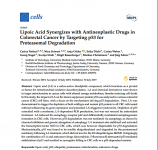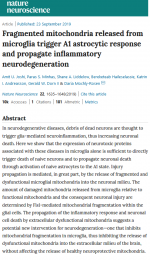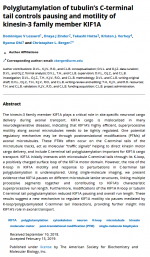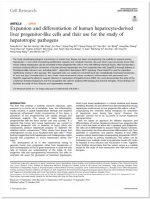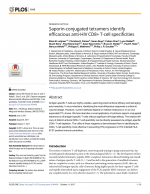15.11.2019
Lipoic Acid Synergizes with Antineoplastic Drugs in Colorectal Cancer... Cells, 2019
Abstract Lipoic acid (LA) is a redox-active disulphide compound, which functions as a pivotal co-factor for mitochondrial oxidative decarboxylation. LA and chemical derivatives were shown to target mitochondria in cancer cells with altered energy metabolism, thereby inducing cell death. In this study, the impact of LA on the tumor suppressor protein p53 was analyzed in various colorectal cancer (CRC) cell lines, with a focus on the mechanisms driving p53 degradation. First, LA was demonstrated to trigger the depletion of both wildtype and...
13.11.2019
Fragmented mitochondria released from microglia trigger A1 astrocytic... Nature Neuroscience 22, 2019
Efforts to reduce the personal and societal burden of neurodegenerative disease (ND) hinge on the identification of the underlying molecular mechanism(s) that causes neuronal death. One common aspect of neuronal death in Alzheimer’s disease (AD), amyotrophic lateral sclerosis (ALS), and Huntington’s disease (HD) is the relationship to the buildup of neurotoxic proteins. Glial cells, normally neuroprotective, can be transformed into a neuroinflammatory state (“A1” for astrocytes) stimulated by this neuronal detritus and by micro...
13.11.2019
Polyglutamylation of tubulin's C-terminal tail controls pausing and mo... Journal of Biological Chemistry, 2019
Recently, Lessard et al. investigated how polyglutamylation of tubulin’s C-terminal tails (CTTs) regulates processivity of the neuron-specific kinesin motor KIF1A. KIF1A transports neuronal cargo anterogradely along axonal microtubules (MTs) over long distances (~3 microns). Prior studies implicated interactions between the K-loop of KIF1A and polyglutamylated CTTs in the regulation of KIF1A motility. The K-loop is a lysine-rich surface loop that attaches the motor to MTs via interactions with glutamate-enriched tubulin CTTs. Single-molecule tot...
13.11.2019
Expansion and differentiation of human hepatocyte-derived liver progen... Cell Research 29, 2019
What is it that makes stem cells such an attractive option for drug discovery studies? One of the main reasons is that they make a much better model of human disease and drug reactions than animal models. The development of an in vitro experimental setting to generate human liver progenitors either from hepatocytes or from cholangiocytes will be of great importance. Fu et al. report an approach for efficient expansion and differentiation of human hepatocyte-derived liver progenitor-like cells in vitro that relies on active SIRT...
12.11.2019
Saporin-conjugated tetramers identify efficacious anti-HIV CD8+ T-cell... PLoS One, 2017
Abstract Antigen-specific T-cells are highly variable, spanning potent antiviral efficacy and damaging auto-reactivity. In virus infections, identifying the most efficacious responses is critical to vaccine design. However, current methods depend on indirect measures or on ex vivo expanded CTL clones. We here describe a novel application of cytotoxic saporin-conjugated tetramers to kill antigen-specific T-cells without significant off-target effects. The relative efficacy of distinct antiviral C...
08.11.2019
Structural determination of the large photosystem II–light-harvesting... The Journal of Biological Chemistry 294, 2019
Abstract In photosynthetic organisms, photosystem II (PSII) is a large membrane protein complex, consisting of a pair of core complexes surrounded by an array of variable numbers of light-harvesting complex (LHC) II proteins. Previously reported structures of the PSII–LHCII supercomplex of the green alga Chlamydomonas reinhardtii exhibit significant structural heterogeneity, but recently improved purification methods employing ionic amphipol A8-35 have enhanced supercomplex stability, providing opportunities for dete...


